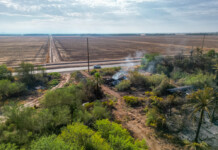
Cardiac arrest is the number one cause of adult death in the U.S. Nationally there are about 400,000 deaths a year; in Arizona there are approximately 18 per day.
Now, however, a new protocol for cardiac codes, ages eight and older, encourages the immediate initiation of chest compressions (200 per minute) followed by electrical shock if possible, then additional compressions. A minimum of 600 compressions would be administered to boost both blood pressure and pulse.
The goal of cardiocerebral resuscitation (CCR) is to increase and maintain oxygen to the heart and brain. CCR provides about a 50 percent oxygen level compared to 10-11 percent with standard CPR measures.
Mouth to mouth resuscitation, which has been problematic for some, will not be part of this new CCR protocol.
Cardiopulmonary Resuscitation (CPR) will still be used for drowning victims, overdoses, trauma cases, pediatric patients or those suffering respiratory arrest.
CCR was developed based on swine studies at the University of Arizona’s Sarver Heart Center. More and more fire and rescue departments in Arizona, including Gilbert, Chandler and Fire Department Maricopa, are adopting the new approach.
Fire Department Maricopa’s Emergency Medical Services Coordinator Cindy Inskeep and Firefighter Engineer/Paramedic Carlos Schulz presented the training for local firefighters on Monday.
“I am really excited about CCR,” said Inskeep. “It has the potential not only to save lives but to improve the quality of life for victims.”
Schulz added, “CCR has shown tremendous results in survivability due to small changes in resuscitation.”
During the first of four training sessions for about 16 firefighters, Schulz reiterated that two-thirds of out-of-hospital cardiac arrests do not receive bystander CPR, which would double the victim’s chance of survival. Even if there is a bystander, the number one reason CPR is not initiated if because of the mouth-to-mouth aspect.
Studies show a 20 percent survival rate for cardiac patients given standard CPR. The use of CCR indicated a 58 percent survival rate, providing the patient’s heart could be shocked back into rhythm.
“It’s hard for those of us who have doing EMS for a long time,” said Schulz, a 15-year paramedic. “The numbers aren’t inflated, and there’s plenty of data on CCR.”
One departure from traditional CPR is that assisted ventilation and intubations are delayed until after spontaneous circulation returns or after 600 chest compressions. Early IV and epinephrine introduction are extremely important.
During a three-year control period, CPR was administered to 92 witnessed cardiac arrests. Eighteen patients survived, and 14 survived neurologically intact–a significant factor in quality of life survivability. Utilizing the CCR protocol on 33 patients, 19 survived with 16 of them neurologically intact.
Confucius is credited with this quotation: “Tell me and I’ll forget, show me and I may remember, involve me and I’ll understand.” That is exactly what Fire Department Maricopa’s training involved. Following a PowerPoint presentation and a demonstration, firefighters practiced CCR on compression models.
To effect the 200 compressions a minute needed for successful CCR, personnel must change off due to fatigue. Each firefighter must know his or her exact job and position during this new, highly successful protocol designed to save the lives of more out-of-hospital cardiac arrests victims.

![Rizz party organizers say city ‘lying’ One of several flyers for a "TikTok rizz party" is taped to a door in the Maricopa Business Center along Honeycutt Road on April 23, 2024. [Monica D. Spencer]](https://www.inmaricopa.com/wp-content/uploads/2024/04/spencer-042324-tiktok-rizz-party-flyer-web-218x150.jpg)
![Province writer opens the athlete’s mind in new book Tom Schuman, a Province resident, poses with a copy of his new book, "My Wide World of Sports," outside his home on May 2, 2024. [Monica D. Spencer]](https://www.inmaricopa.com/wp-content/uploads/2024/05/spencer-050224-tom-schuman-sports-book-web-01-218x150.jpg)








![Maricopa restaurateur makes Food Network connection [Namkeen Dhaba]](https://www.inmaricopa.com/wp-content/uploads/2024/04/439456716_377105198650519_7536248579664805896_n-218x150.jpg)
![Merging lanes incite more 347 anger A merging lane sign sits on the side of State Route 347 northbound lanes during evening traffic on April 30, 2024. [Monica D. Spencer]](https://www.inmaricopa.com/wp-content/uploads/2024/04/spencer-043024-adot-merging-lanes-347-web-218x150.jpg)



![Rizz party organizers say city ‘lying’ One of several flyers for a "TikTok rizz party" is taped to a door in the Maricopa Business Center along Honeycutt Road on April 23, 2024. [Monica D. Spencer]](https://www.inmaricopa.com/wp-content/uploads/2024/04/spencer-042324-tiktok-rizz-party-flyer-web-100x70.jpg)